Learn how to view the transit of Venus on June 5/6.
The upcoming transit of Venus is one of those rare and momentous spectacles in observational astronomy that you absolutely don't want to miss. Unless you expect to live until December 10, 2117, or plan to travel to some other place in the solar system, this will be your last chance to see our sister planet cross the Sun's disk in your lifetime. Read below about what you can expect to see when Venus transits the Sun.
| More transit coverage: |
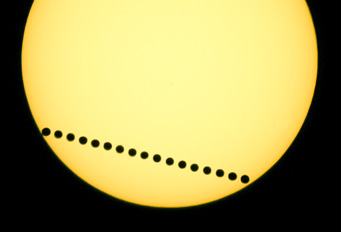
Fred Espenak
Like most people, you probably live in an area with uncertain weather prospects for early June. I strongly recommend that you frequently check weather forecasts several days in advance of June 5th (North and Central America) or June 6th (Asia, Australia, most of Europe, and eastern parts of Africa). If the forecast is looking bad for where you're planning to observe the transit, be prepared to travel to give yourself the best shot at clear skies. At least parts of the transit are visible from most of the world, so this is not like the narrow centerline of a total solar eclipse. Hotels in specific areas won't be booked up years in advance because of the transit.
A transit of Venus is a naked-eye event, meaning people with normal vision can see Venus's disk in front of the Sun without using binoculars or telescopes. (Learn how to safely view the transit.) But for the rest of this article, I'm assuming that you'll be using a telescope for detailed views of the transit, either through direct viewing or by projecting an image of the Sun.
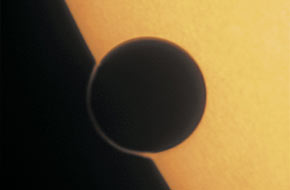
If you have high-quality optics, watch for the "ring of light" effect — one of the many phenomena observed as the planet crosses the outer limb of the Sun's disk. Unlike the black drop, few observers question the validity of this effect.
For me and many other observers from 2004, by far the most exciting part of the event was the beginning and end, technically known as ingress and egress. My most vivid recollection is the moment of first contact. In this context I'm not referring to initial human contact with aliens, but rather the moment when Venus's disk first touched the Sun's outer edge (the limb). I remember being the first in our group to see first contact, and shouting it out for all to hear. Get precise timing predictions for your site, so you're well prepared.
Over the next 18 minutes of ingress, Venus's black silhouette will slowly but dramatically cross the solar limb, until the moment of second contact, when it's entirely inside. Ingress is the part of the transit you really don't want to miss, especially if you live in most of North America and thus can't see the latter stages of the transit. As Venus is entering the solar disk, see if you can spot a ring of light around the edge of Venus. This aureole is due to sunlight refracting through Venus's upper atmosphere.
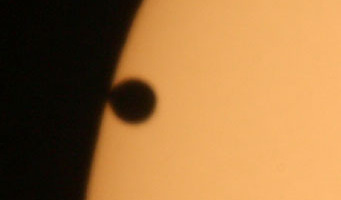
S&T contributing photographer Babak Tafreshi captures the black drop effect when Venus last transited the Sun in 2004.
Babak Tafreshi
Around the time of second contact, look closely for the black-drop effect. If you're a careful observer and have good viewing conditions, there's a good chance that you'll see the black-drop effect. Although the black-drop effect is notorious in astronomy history for preventing precise timing measurements of past Venus transits (which would have yielded a precise distance to the Sun), it's a really cool thing to see in a telescope. For about a minute or so, it will appear as if a narrow bridge of darkness is connecting Venus's limb to the Sun's limb. The effect is caused by telescope optics, the blurring from Earth's atmosphere, and the fact that the Sun gets slightly darker near its edge (an effect known as limb darkening).
Trust me, you don't want to miss the first 20 to 30 minutes of the transit. But in all honesty, the next several hours will be nowhere near as exciting. Venus will basically creep slowly across the Sun, and not much will change from one minute to the next. During the 2004 transit in Iran, the day was so hellishly hot (over 100 degrees F) that I took frequent breaks in a nearby air-conditioned bus, and believe me, I was not alone on the bus. Still, you should frequently check Venus's progress.
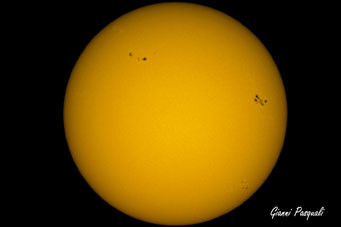
Viewing Venus's profile near a sunspot will show that sunspots are not as black as they sometimes appear.
Gianni Pasquali
But… and this is a big but, you won't want to miss Venus if it comes anywhere near a sunspot. Unlike June 2004, the Sun is quite active right now, so this is not a particularly unlikely event. Check SpaceWeather.com a day or two before the transit to see if there are any large spots on the northern portion of the Sun, near where Venus will pass on transit day. If Venus's silhouette comes anywhere near a sunspot, this will be a perfect opportunity for you to prove to yourself and your friends that sunspots are not really all that dark. Because we see Venus in silhouette during a transit, it will be pitch black. But even the dark center of a sunspot, known as an umbra, only looks dark in comparison to the bright visible surface of the Sun. The contrast between Venus and sunspots should be a stunning sight in a telescope, especially at high magnification.
For those of you who will be viewing the Sun in parts of the world that will see the entire transit, or the final stages, you won't want to miss third and fourth contacts. Basically, egress is a mirror image of ingress, so you should look for the black-drop effect a minute or two before third contact and the aureole around third and fourth contact. If clouds ruined your view of ingress, egress gives you a second chance to study these interesting phenomena.
And this brings me to another important point. Most people will view the transit through a white-light solar filter. But for those of you using telescopes equipped with a hydrogen-alpha filter, you will probably be able to see Venus's silhouette before first contact or after fourth contact if the planet happens to cross in front of a large solar prominence. Views in hydrogen-alpha will also enable you to compare Venus's pitch-black color with dark filaments and other structures on the Sun.
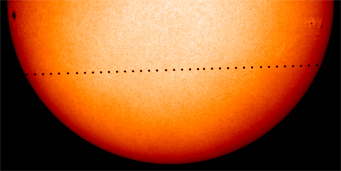
Mercury's path across the solar disk as recorded by an instrument on the Solar and Heliospheric Observatory (SOHO) on November 8, 2006. The next Mercury transit will be in 2016.
NASA / SOHO / MDI
If you just can't get to a spot to witness the upcoming transit of Venus, you can still see more planetary transits in your lifetime. Mercury transits the Sun an average of 13.4 times per century, and the next one takes place less than three years from now: on May 9, 2016. Viewers in North America will be perfectly positioned to see the entire event. But because Mercury is smaller and farther away than Venus, it presents a much smaller disk, and thus transits of Mercury offer considerably less drama and they require binoculars or telescopes.
I also want to encourage you to try to precisely time the contact points, and to submit your timings to organizations that are collecting data from around the world to re-create the experiments from the 1761, 1769, 1874, and 1882 transits of Venus to measure the distance to the Sun using triangulation. If you own an Apple or Droid mobile device, you can download the free Transit of Venus app, which makes this process incredibly easy. Yes, we already know the distance to the Sun from other methods, but it will be fun and interesting to see if amateurs using modern telescopes and timing equipment can outperform the intrepid professionals of yesteryear.
This is it, folks. Unless medical science comes up with an incredible breakthrough, this will be the last transit of Venus visible from Earth in our lifetimes. I wish you safe travels, clear skies, and an unforgettable viewing experience!
 11
11
Comments
Gabriel
May 29, 2012 at 3:58 pm
Does the website that calculates the transit times work for anyone? It is able to find my location great, but it registers "undefined" for all the time values. I live in Georgia, USA, so I should be able to see some of the transit, right? Just curious if anyone else has had problems with the sight, and if any alternative sites are out there.
You must be logged in to post a comment.
Monica Young
May 29, 2012 at 7:50 pm
Thanks, Gabriel, for pointing out that this link leads to a broken website. I've emailed them to let them know about the problem, but for now, I've also replaced our link with a different Venus transit timing calculator: http://xjubier.free.fr/en/site_pages/VenusTransitCalculator.html. This one is a bit more complex in appearance, but does the job just as well :).
You must be logged in to post a comment.
Tim Hutton
May 30, 2012 at 8:07 am
Transit of Mercury on May 9th,2016 is less than three years away?
You must be logged in to post a comment.
Brad Timerson
May 30, 2012 at 8:24 am
Gabriel, it didn't work for me at first. Someone suggested using Firefox or Chrome browsers. I clicked on Compatibility View (at the top) using Internet Explorer 9 and now it works fine.
You must be logged in to post a comment.
Robert Victor
June 1, 2012 at 3:52 pm
In the Venus transit calculator,
http://xjubier.free.fr/en/site_pages/VenusTransitCalculator.html,
the times and the diagram showing Venus' paths across the Sun in both equatorial and horizon coordinate systems appear to be just fine, but in the table, the numerical values of "V", giving the "o'clock" positions of Venus at ingress and other phases of the transit, are not correct. In the calculation of V, the rotation of the solar disk was not taken into account. (Again, the diagram is fine.) I have emailed Xavier Jubier about the problem and hope it will be corrected soon.
You must be logged in to post a comment.
Phil
June 3, 2012 at 11:18 am
Just out of curiosity, how rare is a twofer or a threefer: more than one of a Venus transit, a Mercury transit, or a solar eclipse at the same time? THAT would be something to see! Has anyone ever worked this out, or are they so far in the future (or past) that we can't be certain?
You must be logged in to post a comment.
kaye
June 4, 2012 at 11:45 am
I find this very confusing. You call this a naked eye event that people with normal vision can see w/out binoculars or telescopes. Then you go on to tell how to see it using products and filters I wouldn't even know where to get...especially at this late date.
Can it be seen looking up with binoculars without any filters or sunglasses or any other options without buying or finding any specific products to view it?
I just find it confusing the way this is written.
You must be logged in to post a comment.
kaye
June 4, 2012 at 11:45 am
I find this very confusing. You call this a naked eye event that people with normal vision can see w/out binoculars or telescopes. Then you go on to tell how to see it using products and filters I wouldn't even know where to get...especially at this late date.
Can it be seen looking up with binoculars without any filters or sunglasses or any other options without buying or finding any specific products to view it?
I just find it confusing the way this is written.
You must be logged in to post a comment.
Larry
June 4, 2012 at 12:41 pm
I believe Kaye is not aware of "Pinhole effect". Please never look directly or focus the Sun through any device Not Specifically made for Solar Viewing! Google a Pinhole Camera. 🙂
By the way, the Transit time Computer works Better when I view the page in a mirror.:-)
I Love this stuff.
Thanks S&T
Larry
You must be logged in to post a comment.
Leah
June 5, 2012 at 11:13 am
Kaye - You can't look at the Sun through binoculars without a solar filter, but you could possibly project the image of the Sun onto a piece of paper; just be careful that the binoculars don't overheat. Or, you could go to a local hardware store and look for some #14 welder's glass (with this you could look at the Sun with your unaided eyes.)
I hope everyone has clear skies for this amazing event!!!!
You must be logged in to post a comment.
Robert Victor
September 17, 2012 at 12:38 pm
In the Venus transit calculator,
http://xjubier.free.fr/en/site_pages/VenusTransitCalculator.html,
the times and the diagram showing Venus' paths across the Sun in both equatorial and horizon coordinate systems appear to be just fine, but in the table, the numerical values of "V", giving the "o'clock" positions of Venus at ingress and other phases of the transit, are not correct. In the calculation of V, the rotation of the solar disk was not taken into account. (Again, the diagram is fine.) I have emailed Xavier Jubier about the problem and hope it will be corrected soon.
You must be logged in to post a comment.
You must be logged in to post a comment.